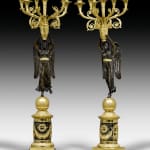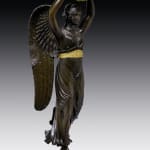Pierre-Philippe Thomire (attributed to) French, 1731-1843
Provenance
From a German private collection.
Literature
Hans Ottomeyer and Peter Pröschel, "Vergoldete Bronzen", 1986, p. 307, colour pl. XXXIX, illustrating an identical pair of candelabra in the Villa Hardt, Eltville. And 328, pl. 5.2.1, illustrating two related studies from a detail on a sheet of designs by Charles Percier of circa 1802 for furnishings for Joséphine Bonaparte's boudoir at Château de Saint Cloud, now in the Metropolitan Museum, New York and pl. 5.2.2, illustrating one of a similar pair of candelabra by Pierre-Philippe Thomire with Victory likewise standing on one foot and noting that a related drawing of those candelabra appear in Thomire's album of 1817, now in the Stockholm Nationalmuseum. And p. 329, pl. 5.2.4, illustrating a very similar pair of ten-light candelabra à la Victoire by Pierre-Philippe Thomire of circa 1810 in the Metropolitan Museum, New York.
A very fine pair of Empire gilt and patinated bronze and vert de mer marble six-light candelabra attributed to Pierre-Philippe Thomire after a design by Charles Percier, each with a patinated winged figure of Victory wearing diaphanous robes gathered by a gilt sash holding aloft a candelabrum formed as a vase mounted with winged zephyr masks issuing a central upright candle branch surrounded by five other foliate-wrapped branched lights terminated by a vase-shaped candle holder, each classical figure balancing on one foot upon a sphere raised on a palmetted base on a circular vert de mer marble pedestal mounted with gilt foliate wreaths centred by a bow and arrow above a floral and foliate swags hung from foliate trophies, on a stepped square base
Paris, date circa 1810-15
Height 90 cm. each.
The personification of Victory as a winged figure was well known in Antiquity as evidenced by a Roman model showing a very similar figure upon a sphere, now in the National Art Collection, Kassel (illustrated ibid. p. 329, pl. 5.2.3). The figure became an integral element within Empire design through the intervention of Charles Percier (1764-1838) and Pierre François Léonard Fontaine (1762-1853), Napoleon's most important architects and designers. The design for the present pair of candelabra is believed to have derived from a design by Charles Percier (as cited above) which was successfully exploited by both Pierre-Philippe Thomire (1751-1843) and Claude Galle (1759-1815).
Given their superb quality and close comparison with other examples, these candelabra are almost certainly the work of the preeminent bronzier Pierre-Philippe Thomire. Close inspection reveals the mastery of the chasing, from the free flowing robes that subtly outline the female form, the seemingly naturalistic feathered wings to the winged zephyr masks. In addition to the pair in the Metropolitan Museum are another pair of comparable design at Château de Fontainebleau, which was acquired in 1804 for the salon de l'Impératrice (J. P. Samoyault, "Pendules et Bronzes d'Ameublement Entrés sous le Premier Empire", 1989, p. 156, no. 133). A further related pair of candelabra was sold from Sheringham Hall, Norfolk in October 1986.
Pierre-Philippe Thomire was the greatest craftsman of his age to work in gilt bronze. He was patronised by Louis XVI, Napoleon and Louis XVIII as well as foreign monarchy and aristocracy. His fame and notoriety was then propelled to even greater heights after the Revolution when in 1806 he became the first bronzier to be awarded a gold medal at the Exposition des Produits de l'Industrie. In 1809 he won another gold medal and was also appointed ciseleur de l'Empereur. In addition to Napoleon himself Thomire was patronised by the Emperor's family and many foreign royal courts.



